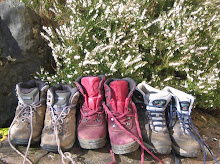
Scotland’s National Plant?
We contest that Sphagnum in all its glorious colours be the true ‘Flower of Scotland’, on account of its wide ranging household and medicinal purposes down through the ages. A natural antibiotic and antiseptic, this prolific moss has seen use as a wound dressing (as recently as World War II) and was the original toilet paper, sanitary towel and disposable nappy. In lieu of the humid climate on Mull, one of its greatest redeeming qualities, due to its marvellous absorbency, was to minimise leaks and to increase insulation in buildings. It could be said that, without it, the Isle of Mull would be populated by drips! – 18/05/11

Sensitive and Sexy
The club-shaped antennae of this Small Pearl-Bordered Fritillary butterfly are the insect’s primary organ of smell. Packed with extra-sensory nerve receptors, which can detect minute dilutions of scent, antennae on females home in on the scent given off by prospective mates. Special scent-releasing glands on some of the scales of a male butterfly produce powerful pheromones that induce a sexual frenzy among those females that become overwhelmed. That great smell of Brut doesn’t quite have the desired effect! – 04/06/11

Yummy and Scrummy
With the blackberry picking season now upon us, our fingers will soon be dyed rich purple-red with the sumptuous fruits of this wildlife-friendly plant. We will be able to look forward to spreading delicious Mull Magic bramble jelly on our morning toast and to imbibing on a blackberry wine as a toast of a different sort to this amazing plant. Honey Bees, Bumblebees, Drone Flies and Hoverflies all take advantage of the nectar-rich flowers, which have a very long season here on Mull – 14/09/11

The Prototype for the Caribbean
Much of the 305 miles of Mull’s coastline consists of rocky shores yet, particularly in the North-west and South of the island, the almost white sand beaches are a rival to those in warmer parts of the world. Indeed, beaches on the Isle of Mull are often said to resemble those in the Caribbean or the Greek Islands. There is only one thing wrong in that assertion: it is the beaches on Barbados and Corfu that look like those at Calgary Bay and Langamull. The Isle of Mull may only be a young island, but we were definitely here first! – 29/04/11

Mother Nature’s Water Pistols
The earliest human settlers on Mull would have made good use of the many different kinds of seaweed that thrive along the coast of the island. Indeed, wrack was an essential commodity in the lives of the islanders far into the 20th Century, as animal fodder, green manure, to be eaten raw or included in stews, soups and puddings. The largest bladders of the most common seaweeds were often collected by children, who’d bite off one end and immerse it in water. Once filled, the children had a ready-made water pistol to greatly annoy their friends and parents with! – 08/03/11



No comments:
Post a Comment